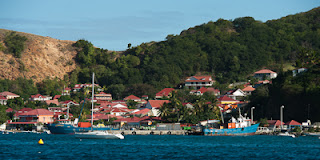 |
| Bourg les Saintes |
Bourg les Saintes is occupied by a predominantly white
population, descended from original Norman settlers. It has escaped the tourist
development and so, has itself become a tourist draw. Visitors flock on the day
boats from Guadeloupe but, out of hours, it is as sleepy as a Fenland village.
 |
| Crested Hummingbird |
Matthew and I climbed the hill to Fort Napoleon and were
treated to stunning views over the islands and iguanas. We had hoped to come
across these large lizards on the other islands but finally found them here. We
also found an American kestrel, hunting for smaller lizards.
 |
| Iguana guards Fort Napoleon |
Beneath the waves, again the guidebook dive sites proved
unremarkable. The rock reef around the mini-piton Pain de Sucre showed signs of
silting and over-snorkelling near the wonderful beach at Anse a Cointre but
improved when I went deeper and further towards the north east. The main
feature was damaged coral and decaying reef – I am no longer surprised at the
increased incidence of ciguatera poisoning here as this is thought to be
related to toxins from dying reef. Another result was in increase in larger
predatory fish. I have finally seen decent sized porgies and snappers. Both
children enjoyed the plethora of tiny fish in the shallows and Elizabeth
spotted a ray.
 |
| Croix des Gardes at anchor |
Later we moved again to the barely-inhabited Terre D’en
Bas to anchor in Anse Fideling. This gently shelving sandy bay is fringed by
rocky caves and promised good snorkelling. The fan coral damage was less than
the more popular spot we’d left earlier, but the corals were still in mediocre
health. Elizabeth and I rounded one boulder to find a small eddy, filled with
plastic litter from tourists and yachts – water bottles, toothpaste tubes and
yoghurt pots were among the identifiable refuse along with a discarded lobster
pot.
 |
| Discarded nylon rope |
I am rapidly coming to the conclusion that no anchor
zones, such as those in the marine parks of Dominica and St Lucia are hugely
beneficial to the reef, not solely because they reduce physical damage from
anchors, but they eliminate the more insidious peril of visitors discharging
sewage, litter and seeping oily residues into the delicate ecosystems. Tomorrow
we head for the Jaques Cousteau’s marine reserve at Pigeon Island to see what
difference that has made.
You must have a good camera to freeze that Hummingbird's wing. One of the problems for Caribbean coral is the slight increase in CO2, which is increasing the acidity of the sea reducing the coral growth rate and ability to recover from damage. Lots of love Dad XXXXX
ReplyDelete